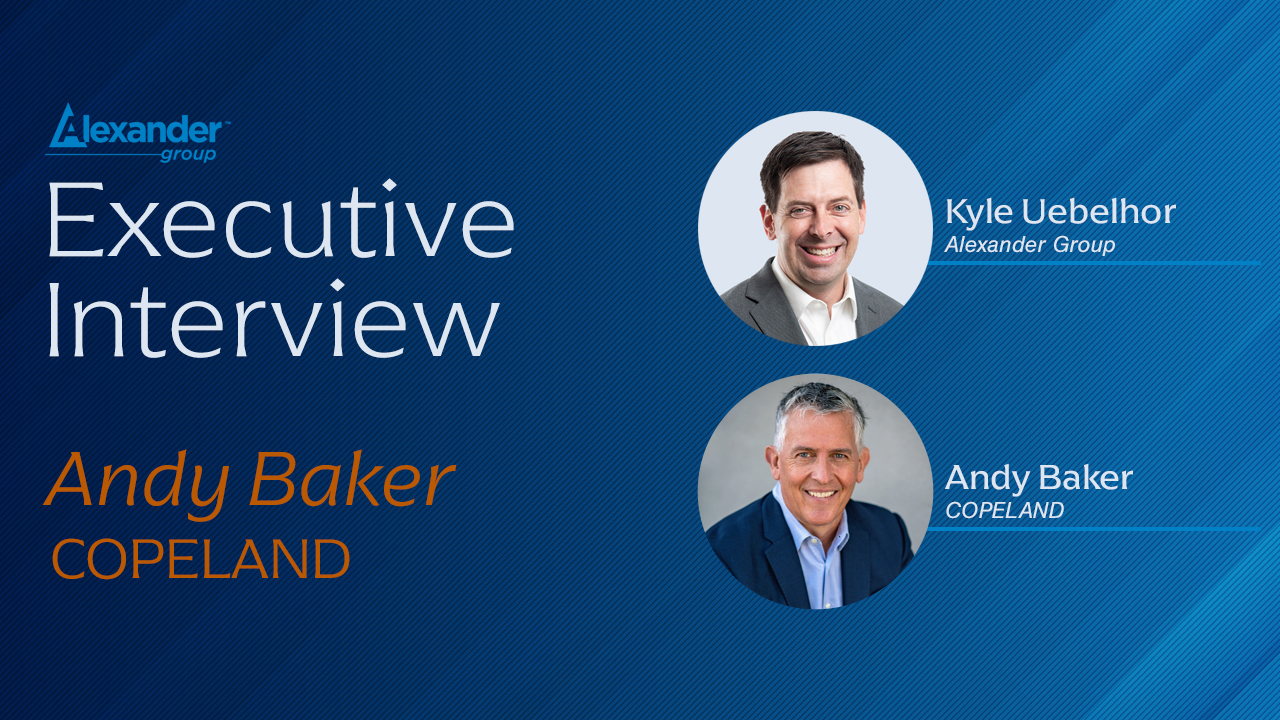Arshad Carim: In recent Alexander Group research, we found that 32% of manufacturers are increasing their headcount for customer success in 2024 and 25. Welcome, everyone. It’s nice to see you. I’m here with my colleagues Kyle Uebelhor and Andrew Horvath. I’m Arshad Carim. We’re leaders in the Alexander Group’s Manufacturing and Distribution Practice, and we’re here to share with you today recent findings from a study we just conducted with over 250 chief commercial and revenue officers, and interviews with over 100 people at large B2B companies in our space. And we wanted to share with you some of the highlights that we’re seeing from this research and some of the hottest topics that are on the minds of executives today. And those are around what are we seeing with demand generation? What did our research tell us around customer success as well as everyone’s favorite topic, artificial intelligence and its impact on commercial roles and then talent. And it’s really about how these things are being impacted in terms of the roles in your commercial organization and what you might want to think about doing about it over the next year or two. So welcome, Kyle, Andrew, good to see you. And I’m going to kick it off here with Kyle and share a little bit with us on what we saw related to demand generation.
Kyle Uebelhor: You know it’s interesting Arshad I’m going to kind of bring this together because we saw two major themes come up with the types of new roles that are really being implemented in manufacturing and distribution organizations. We’ve seen this through some client work, but it’s now really manifesting itself in the research and the data. Specifically, demand generation roles, or BD roles, are really taking on a new sort of valence and really a higher degree of efficiency and impact that we’re seeing from those demand gen roles. And I think the other number two role, and I’m going to talk about this in a second, and you alluded to it earlier, the customer success roles. Those two roles are absolutely the most dynamic roles we’re seeing being instilled in go-to-market models. And it’s really two of the more important things that I think everyone should be thinking about. If we think about demand gen, I think that’s a kind of a broad topic, but what we do know from the research is that the share of marketing contribution towards overall pipeline grew by about 5%. So, the marketing organization is connecting into the sales organization to the true pipeline development. And a lot of that’s being manifested with not only are we creating more pipeline, but we’ve got roles specifically designed to help accelerate the pipeline. If you think about demand gen roles, I think that oftentimes we’ve got this generic term called “business developer.” Well, actually, what we found there are five unique types of BD, or business development, demand gen roles that are out there these days. And I think that spectrum of roles is really important. You need to understand, what are you trying to do? Is it more of a marketing and digital coverage on one end of the spectrum, or do you really need that sort of true classic BD hunter, that sales rep that’s out in the field and his or her sole responsibility is going out and getting new logos. And there are several variations in between. I think that’s the thing to remember. Five kind of unique demand gen roles that we found. And I think you have to figure out which one you want, but those organizations that are doing it, we saw some success.
Arshad Carim: So diversification of the roles that are involved and some more investment going in there for sure. Interesting.
Kyle Uebelhor: Exactly, exactly. And then as I mentioned earlier. The other thing that struck us with what types of new jobs are out there, if you’ve got the demand gen or this business development on the front end of your sales cycle, the back end of the sales cycle is getting just as much, if not more attention. And I think this is the fascinating piece, the emergence of customer success managers, CSMs, or this customer excellence or customer success roles, is absolutely coming into our own in the manufacturing and distribution space. We’ve seen it elsewhere. It’s been in a part of the tech industry, part of the software industry for years. Now we know that this after the sale individual, the CSM, Customer Success Manager, is a predominant role that’s being built into many go-to-market strategies, because what manufacturers are realizing, they need to ensure that the value that we’ve promised is being delivered. And what’s unique about these CSM roles as they get developed. They’re not just customer service, they truly are building a sustaining relationship with those end users at that point after the point of sale. And we’re finding that not only do they enhance the sort of the stickiness or the customer lifetime value of an individual account or client, they’re actually finding ways to upsell as they’re in it. So it’s really a team environment from a business development on the front end to our traditional sales organization, whatever that might look like, to these new CSM roles on the backside and this manifestation of both business development or demand gen with CSM roles, are the wave. I think those are the things we’re seeing most people trying to get in front of.
Arshad Carim: And from our research. Kyle too, there’s a lot of different flavors of that role in terms of how you define it, right? It really depends on, hey, are you going after more focus on the renewals? Are you really honed in on that adoption or expansion? How do you constitute that role? How much skin in the game do they have from a comp perspective that all plays into it, right?
Kyle Uebelhor: That’s exactly right, Arshad. I’d say kind of you really need to have an insightful look at what you’re trying to accomplish with the job, because not only is it a highly valuable job, it does have a cost associated with it. You have to make sure you’re clearly defining the job, so you set these individuals up for success and you’re getting the ROI out of it on the backside as well.
Arshad Carim: And I think in our space, right, this manufacturing and distribution space, there’s a real connection between that CSM role deployment and recurring revenue models. And the rise of those recurring revenue models.
Kyle Uebelhor: I heard a CEO tell me a couple of days ago, and I’ll end on this note, is that the CSMs are not only helping them think about recurring revenue, but it’s ensuring predictable revenue. That’s the thing I think people are looking for two to three to four quarters ahead. Having a CSM role in place, you know that you’ve got that customer lifetime value being inherently built. So even if you don’t have a revenue model that’s created off a service subscription or some sort of inherent recurring motion, if you can even get more predictable with how you looked at the forecast of the future, regardless of your equity structure, it’s a very powerful tool in your kit.
Arshad Carim: And CSMs can be a key to doing that. Makes sense. Well, let’s keep going and get Andrew engaged here. Andrew, we’ve got a topic that I know is near and dear to your heart, artificial intelligence and how it’s impacting commercial roles. So tell us, tell us what’s going on there.
Andrew Horvath: We did some research here, and the idea was to understand the impact of AI, gen AI and automation on commercial sales roles. So as you can imagine, there’s a plethora of roles out there. And, you know, we learned from folks that are really living this, that there’s a pretty big spread where certain roles will be impacted more than others. And, you know, came down to the idea that a lot of the pre-sales and post-sales roles are probably the most impacted. So think lead gen, BDR, pre-sales support, CSMs and post-sales, similar to what Kyle was talking about earlier. Those are the roles most likely to be impacted. And I think part of the reason is because if you take some roles that have a large customer base or large prospect pools that require a lot of manual work right now, think identifying leads, qualifying leads, those roles can be really amplified in terms of their productivity with some of these AI tools. Some of our clients, especially in the PE space, are using AI tools to create customized pitch decks and content for prospects across multiple end markets. So you think about taking a pitch that used to take, hours or days, and now you’re able to take that and turn it into a very end market or customer specific material at the push of a button. Some of those roles are going to be very much impacted by this tool. And on the back end, I think a lot of the activities around quoting and the where’s my order request have begun to be handled by AI tools so that can free up those roles to be more productive. There will be an impact on in person roles, think field account sellers, industry experts and key account managers. They can still be the face to the customer. A lot of the back end or the work that kind of goes into their job will be automated, but you’re still limited by in-person face time, number of accounts, relationship building and travel time. Those will still be limiting factors, but that role also can be positively impacted.
Arshad Carim: I’m connecting it back to our CSM discussion, and you can think about the impact that the AI will have on that CSM role and how productive they can be if AI is helping them figure out, hey, by analyzing all this data, I know what that customer needs next, or I know where they’re deficient. So there’s some serious impact there.
Kyle Uebelhor: Or what we’re also seeing is this customer is at risk. What are the things that we need to do to make sure that we’re not going to lose them? So it’s both that where can you find growth, but how do you make sure you plug a leaky bucket as fast as possible? It’s really powerful. But guys, I don’t know about you, but what this whole set of research told me is that it still requires human interaction. That relationship and the sales person still matters.
Arshad Carim: Still matters.
Andrew Horvath: We heard a use case where there was a software sale. I know we’re a bit outside the bounds of manufacturing and distribution, but a software sale where the SDR got on the phone for the last three minutes of a negotiation just to be able to be the one that finally set the contract price. Three minutes of work versus an hour and a half in a prior world. So, Kyle, you’re right, the person needs to be behind that role at some very critical points in the sale.
Arshad Carim: Awesome. All right. Well, let’s move on to our last topic, which is around talent and what we’re seeing with talent and the importance of managing it properly. And what are some of the trends there, I think, Andrew, you’ve got some thoughts on talent.
Andrew Horvath: You know, I think it’s one of those where if you could snap your fingers and all of a sudden provide a talent pool stock with the best and brightest to manufacturers and distributors that would be invaluable. But in the absence of that magic bullet, some of the things that we’ve come across in our research, there are really five main pillars of a talent program. One, of course, is talent acquisition. So where are we looking? What are the pools that we’re looking in to go hire? Is it competitive? Is it out of market? Is it some other combination of that? But you think about the strategic architecture of our talent. How do you actually take the skills and competencies of a seller or marketer or service person and match them to the role profile? Comp is always a big one. That’s sort of a constant. We have to make sure that we’re aligning that comp program with the talent that we want and want to grow. Coaching is something we’ve been talking about for years, that sales manager cadence, to be able to coach up sellers, to really move that middle to more productivity. The employee experience as well. So understanding what that life cycle looks like for new folks, veterans, making sure they have that opportunity to grow and develop. We did see some stats come across where the one that really got my attention was good training, and that could be both third party as well as internally built, think product training or training in how our customers actually buy. The research came back and said that 9% higher annual recognized revenue growth could be achieved with well-built programs there. So training is usually a pretty big line item in any budget but making sure that you’re getting the ROI and the bang for the buck there is critical. And I think one of the other items that popped up is that understanding what that baseline is is critical as well. So we can train, but we need to understand what the capabilities of our current team is. So what a talent profile and a talent assessment looks like can directly inform that training program and how deep we have to get there.
Arshad Carim: All right, well talent, big impact, 9%. That’s a good number. You heard it here, talent, AI, demand generation, customer success. All these things are hot topics right now. Investment going into them, new things happening. Stay tuned to the Alexander Group for more on this. If you’d like to discuss further, give us a call. Look at our website, Alexander Group.com. And we’d love to chat with you further if you have interest in any of these topics. Thanks for listening.







